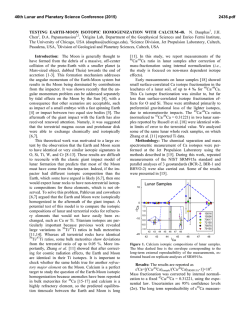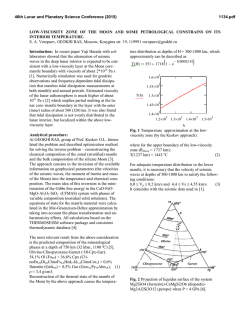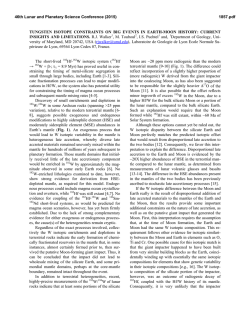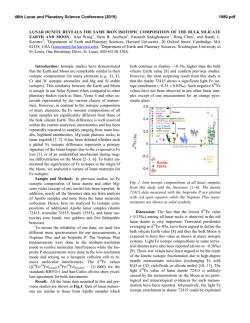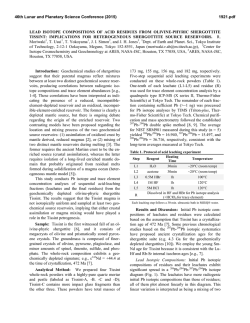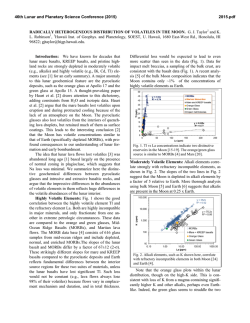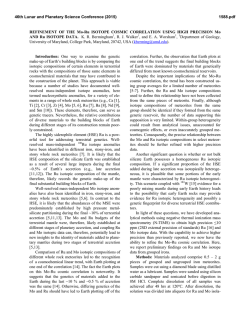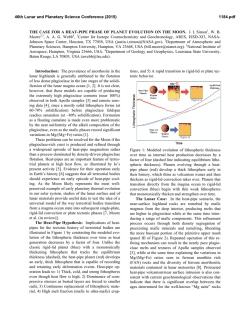
Hf-W AND THE ISOTOPIC CRISIS FOR THE GIANT IMPACT
46th Lunar and Planetary Science Conference (2015) 2827.pdf Hf-W AND THE ISOTOPIC CRISIS FOR THE GIANT IMPACT ORIGIN OF THE MOON. S. B. Jacobsen1, F. Sedaghatpour1, M. I. Petaev1,2 , and G. Yu1. 1Department of Earth & Planetary Sciences, Harvard University, Cambridge MA 02138; 2Harvard-Smithsonian CfA, Cambridge MA 02138. Introduction: It has become clear over the last few years that the widely accepted model for the origin of the Earth-Moon system as the result of a Mars-sized giant impactor colliding with proto-Earth is inconsistent with a variety of new isotopic data. Generally, it is thought that the Earth and the Mars-sized Moonforming impactor were isotopically different (for mass independent isotopic variations). Therefore, according to the canonical Moon forming SPH simulations, the Earth and the Moon should end up isotopically different from each other and that is inconsistent with observations. In contrast, isotopic studies have demonstrated that the Earth and Moon are remarkably similar in their isotopic compositions for many elements (notably mass independent isotopic compositions of O, Ti, Cr and W, and mass dependent isotope compositions of Mg and Si). This similarity between the Earth and Moon is unique in our Solar System when compared to other planetary bodies. This unexpected similarity has been called an isotopic crisis for the giant impact origin of the Moon [1]. It provides a fundamental constraint on the theory of the origin of the Moon; any successful model must properly explain such similarity between the Earth and Moon. Thus, a model for the Earth-Moon isotopic equilibration subsequent to the giant impact was developed [2], but such a model require rather special conditions to be valid. Therefore, recently [3] and [4] discussed new and different SPH simulations that predicted ways of making the Earth and Moon into almost isotopic twins. In the new giantimpact models [5,6] lunar material is derived either from a range of depths in the proto-Earth’s mantle or equally from the entire mantles of two colliding halfEarths. These scenarios are more likely to produce a Moon with the same or very similar isotopic fingerprint as the Earth. Here we explore the case of the 182Hf-182W evolution as many previous studies have argued that the 182 W/183W isotopic compositions of the Earth and Moon are essentially the same. We show that this radiogenic isotope system is not very likely to lead to identical W isotope compositions of the Earth and Moon. The W isotope composition of lunar samples: Measurements of the W isotope compositions of lunar samples potentially provide constraints on both (i) the age of the Moon and its earliest differentiation and (ii) the bulk W isotope composition of the Moon and whether or not it is identical to the Earth’s mantle. The measured W isotopic composition of metals from lunar High-Ti, Low-Ti mare basalts and KREEP-rich samples [7], which contain only trace amounts of Ta and consequently require negligible correction for cosmogenic 182W from 181Ta, reveal that W of these metals (0.09 ±0.10) are indistinguishable from each other and from the terrestrial samples. A measurement on ferroan anorthosite 60025 by [8] yields W = -0.03 ±0.30 and also supports identical W isotope signatures of the Earth’s mantle and the Moon. Recent very high precision measurements argue that the 182W/183W of the Moon is only 10 to 15 ppm higher than the bulk silicate Earth [9]. Figure 1. (a) Hf/W ratios (as fHf/W) in Earth’s upper and lower mantles as a function of the mass fraction of the growing Earth. (b) Evolution of the W isotopic composition (as εW) in the Earth’s upper and lower mantles over time (Myr), assuming no mixing between these reservoirs. The 182W/183W evolution of the Earth and the origin of the Moon: Depletion of siderophile ele- 46th Lunar and Planetary Science Conference (2015) ments in the terrestrial mantle has been suggested to be consistent with a core formation model in an intermediate deep magma ocean of a thickness corresponding to 31-35% of the depth of the Earth’s mantle [10-12]. If this is correct, then the “deep magma ocean” core formation model can also be applied to the Hf-W system in the early Earth. Consequently, the early Earth should also have a two-mantle-reservoir structure with different Hf/W ratios and W isotopic compositions as shown in Figure 1. However, so far, all young terrestrial basalts show no detectable heterogeneity in 182 W/183W, although small W isotope heterogeneity has been reported in the rocks of 2.8 and 3.8 Ga [13-15]. The isotope composition of the bulk silicate Earth appears to be εW(CHUR) = 1.9±0.2 [13], with only 15 ppm higher values in some of the oldest terrestrial rocks [14-15]. As shown in Figure 1, the expected W isotope compositions of terrestrial mantles produced by the “deep magma ocean” core formation processes are much larger. This point to a process that erased this early signature. The mechanism to erase or reduce the predicted W isotope heterogeneity in Earth’s mantles derived from the “deep magma ocean” core formation model could be either (i) a complete melting caused by a Moon-forming giant impact or (ii) the 4.5 Ga-long active mantle convection in the Earth. The former is hard to test now while the latter is testable. It has been shown by [16] that the present Earth mantle heterogeneities in the long-lived isotopic systems (87Rb-87Sr and 147Sm-143Nd) can be reproduced by a 500 Myr mantle stirring rate and 30-100 km sampling size of basalts. [17] tested the latter hypothesis using the principals from [16] and concluded that a mantle stirring rate of 500 Myr would be able to reduce the bimodal W isotopic compositions in Earth mantles predicted by the “deep magma ocean” core formation model to a W isotopic heterogeneity scale of only ~84 m in the Earth’s mantle today. Given a 100 km sampling size of terrestrial basalts that is much larger than 84 m, a homogeneous well-mixed W isotopic composition is expected for all modern terrestrial basalts. Thus, while 4.5 Ga of mantle upper and lower mantle mixing predicts the observed W isotope composition of the silicate Earth, it makes it relatively unlikely that the Moon has the identical W composition to the Earth and is a problem for the giant impact model. The requirement is, the unlikely situation, that the Moon is made of the same mixture of upper and lower terrestrial mantle material and impactor material as the Earth. Hf/W ratios in the Earth and Moon and condensation of Hf and W in the lunar disk: The difference in Hf/W ratios of the Earth and Moon estimated by [7] has been questioned by [18]. This difference is also inconsistent with the indistinguishable Ba/W ratios of 2827.pdf terrestrial and lunar rocks [19]. The Hf/W ratio of the bulk mantle of the Earth and Moon cannot be measured directly, but can be inferred by comparing the W concentrations with another element (such as Ba, Th or U) with partitioning similar to W during silicate melting. The Hf/W ratio of a bulk planetary mantle (m) can thus be estimated by: (Hf/W)m = (Ele/W)m(Hf/Ele)CHUR (Ele = Ba, Th or U), where CHUR denotes the chondritic value. The indistinguishable Ba/W ratios of terrestrial and lunar rocks reported by [19] imply that the bulk silicate Earth and Moon likely have the same Hf/W ratios, in contrast to the estimates used by [7]. A more convincing way to estimate Hf/W in the bulk silicate Moon is to compare a set of precise Ba, Th, U and W concentrations in various lunar rocks as is now available for terrestrial samples [20-21]. We are conducting further Hf-W concentration measurements of lunar samples in an attempt to resolve this problem. If the Hf/W ratio and the W isotope composition of the Moon and Earth’s mantle-crust system are the same, then the Hf-W chronometer provides no chronological constraint on the time of formation of the Moon. However, if they are different it suggests late formation of the Moon (based on W isotopic measurements of [7]. Modeling of Hf/W ratios in the lunar disk will also provide important constraints on understanding how to use this isotopic system to test the giant impact origin of the Moon. References: [1] Melosh H. J. (2009) MAPS Supplement. 5104. [2] Pahlevan K. and Stevenson D.J., (2007) Earth Planet. Sci. Lett. 262, 438–449. [3] Elliott T. (2013) Nature 504, 90. [4] Stewart S. T. (2013) Nature 504, 91. [5] Ćuk M. and Stewart S. T. (2012) Science 388, 1047-1052. [6] Canup R. M. (2012) Science 338, 1052-1055. [7] Touboul M. et al. (2007) Nature 450, 1206-1209. [8] Touboul M. et al. (2009) Icarus 199, 245-249. [9] Touboul M. et al. (2014) LPS XXXXV, Abstract #1851. [10] Wade J. and Wood B.J. (2005) Earth Planet. Sci. Lett. 236, 78-95. [11] Yu G. and Jacobsen S.B. (2011) PNAS 108, 17604-17609. [12] Rubie D.C. et al. (2011) Earth Planet. Sci. Lett. 301, 31-42. [13] Yin Q.Z. et al. (2002) Nature 418, 949-952. [14] Willbold M. et al. (2011) Nature 477, 195-198. [15] Touboul M. et al. (2012) Science 335, 1065-1069. [16] Kellogg J.B. et al. (2002) Earth Planet. Sci. Lett. 204, 183-202. [17] Jacobsen S.B. and Yu G. (2012) LPS XXXXIII, Abstract #1659. [18] Yin Q. Z. and Antognini J. (2008) Geochim. Cosmochim. Acta 72, 12. [19] Wieczorek et al. (2006) Reviews in Mineralogy and Geochemistry 60, 221-364. [20] Arevalo R. and McDonough W. F. (2008) Earth Planet. Sci. Lett. 272, 656-665. [21] Konig S. et al. (2011) Geochim. Cosmochim. Acta 75, 2119-2136.
© Copyright 2026
